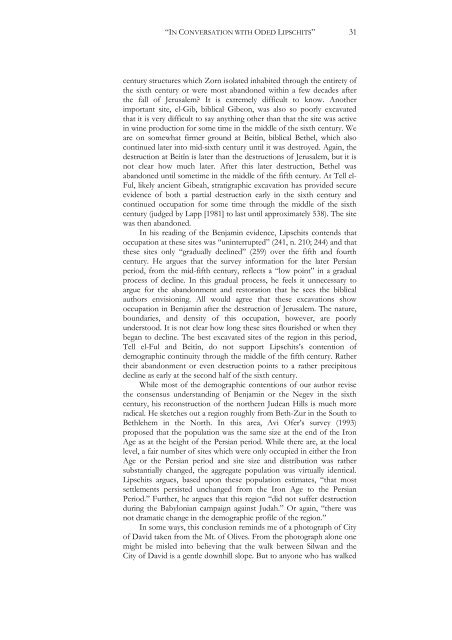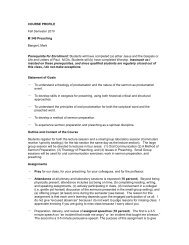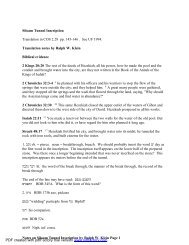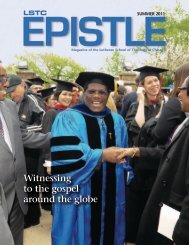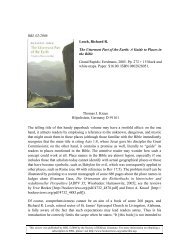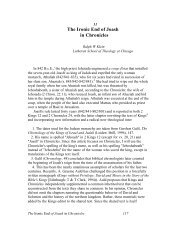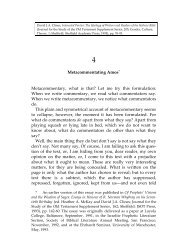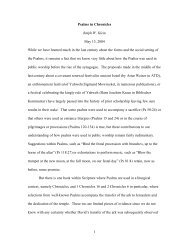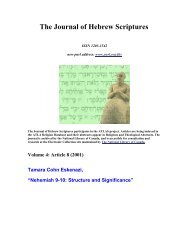Download this PDF file - University of Alberta - Journal Hosting
Download this PDF file - University of Alberta - Journal Hosting
Download this PDF file - University of Alberta - Journal Hosting
Create successful ePaper yourself
Turn your PDF publications into a flip-book with our unique Google optimized e-Paper software.
“IN CONVERSATION WITH ODED LIPSCHITS” 31century structures which Zorn isolated inhabited through the entirety <strong>of</strong>the sixth century or were most abandoned within a few decades afterthe fall <strong>of</strong> Jerusalem? It is extremely difficult to know. Anotherimportant site, el-Gib, biblical Gibeon, was also so poorly excavatedthat it is very difficult to say anything other than that the site was activein wine production for some time in the middle <strong>of</strong> the sixth century. Weare on somewhat firmer ground at Beitîn, biblical Bethel, which alsocontinued later into mid-sixth century until it was destroyed. Again, thedestruction at Beitîn is later than the destructions <strong>of</strong> Jerusalem, but it isnot clear how much later. After <strong>this</strong> later destruction, Bethel wasabandoned until sometime in the middle <strong>of</strong> the fifth century. At Tell el-Ful, likely ancient Gibeah, stratigraphic excavation has provided secureevidence <strong>of</strong> both a partial destruction early in the sixth century andcontinued occupation for some time through the middle <strong>of</strong> the sixthcentury (judged by Lapp [1981] to last until approximately 538). The sitewas then abandoned.In his reading <strong>of</strong> the Benjamin evidence, Lipschits contends thatoccupation at these sites was “uninterrupted” (241, n. 210; 244) and thatthese sites only “gradually declined” (259) over the fifth and fourthcentury. He argues that the survey information for the later Persianperiod, from the mid-fifth century, reflects a “low point” in a gradualprocess <strong>of</strong> decline. In <strong>this</strong> gradual process, he feels it unnecessary toargue for the abandonment and restoration that he sees the biblicalauthors envisioning. All would agree that these excavations showoccupation in Benjamin after the destruction <strong>of</strong> Jerusalem. The nature,boundaries, and density <strong>of</strong> <strong>this</strong> occupation, however, are poorlyunderstood. It is not clear how long these sites flourished or when theybegan to decline. The best excavated sites <strong>of</strong> the region in <strong>this</strong> period,Tell el-Ful and Beitîn, do not support Lipschits’s contention <strong>of</strong>demographic continuity through the middle <strong>of</strong> the fifth century. Rathertheir abandonment or even destruction points to a rather precipitousdecline as early at the second half <strong>of</strong> the sixth century.While most <strong>of</strong> the demographic contentions <strong>of</strong> our author revisethe consensus understanding <strong>of</strong> Benjamin or the Negev in the sixthcentury, his reconstruction <strong>of</strong> the northern Judean Hills is much moreradical. He sketches out a region roughly from Beth-Zur in the South toBethlehem in the North. In <strong>this</strong> area, Avi Ofer’s survey (1993)proposed that the population was the same size at the end <strong>of</strong> the IronAge as at the height <strong>of</strong> the Persian period. While there are, at the locallevel, a fair number <strong>of</strong> sites which were only occupied in either the IronAge or the Persian period and site size and distribution was rathersubstantially changed, the aggregate population was virtually identical.Lipschits argues, based upon these population estimates, “that mostsettlements persisted unchanged from the Iron Age to the PersianPeriod.” Further, he argues that <strong>this</strong> region “did not suffer destructionduring the Babylonian campaign against Judah.” Or again, “there wasnot dramatic change in the demographic pro<strong>file</strong> <strong>of</strong> the region.”In some ways, <strong>this</strong> conclusion reminds me <strong>of</strong> a photograph <strong>of</strong> City<strong>of</strong> David taken from the Mt. <strong>of</strong> Olives. From the photograph alone onemight be misled into believing that the walk between Silwan and theCity <strong>of</strong> David is a gentle downhill slope. But to anyone who has walked


